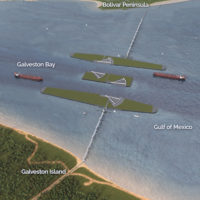The bridge reopened Feb. 1. Work has begun on replacing the roughly 300- meter-long broken cable and another damaged cable. The $870-million, 2.25-kilometer-long link to the Peloponnese peninsula opened last August.
Lightning struck the top 25-centimeter-dia cable in the southwest fan of stays over the 286-m span nearest Rion, say investigators. It set the high-density polyethylene and wax corrosion protection on fire, about 100 m from the first pylon.
Staffers discovered the fire about an hour later and closed the bridge within minutes. The burning cable snapped at about 11:20 a.m., 40 minutes after the closure. The falling cable sparked a flame in the sleeve of the one below it.
After tests ordered by bridge opera-tor Gefyra S.A., Athens, the bridge was deemed "100% safe," says Michel Virlogeux, a top French bridge engineer. Paris-based Vinci Group, a Gefyra shareholder, led the project's design and construction. The incident was a "scenario which has never been imagined," he adds.
The broken cable contains 64 South Korean-made parallel strands. Each has seven wires set in wax and sheathed in high-density polyethylene. Loose polyethylene casings enclose the stays. The structure is designed to resist full load with up to two cables missing.
From witness accounts, "it looked like horizontal lightning [hit] the cable," says Benoît Lecinq, technical director of Freyssinet International S.A., Paris, part of the stay cable erection team. The lightnings intensity was "exceptional," he adds.
Similar cables at the U.K.s Second Severn Bridge survived intense heat from a burning truck five years ago, says Neil Adamson, associate with Flint & Neill Partnership, London.
Lecinq says the incident should not undermine confidence in parallel strand cables. But he concedes that more effective lightning conductor design is needed. Conductors atop pylons on the Greek bridge work in a 70-m rangeabout 30 m short of where the lightning struck.
reak horizontal lighting cut down one of the longest stay cables on the vast, five-span Rion-Antirion bridge in Greece Jan. 27, engineers have concluded. The strike caused no injuries or serious structural damage.

Post a comment to this article
Report Abusive Comment